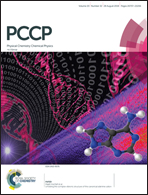Thermochemistry of the smallest QOOH radical from the roaming fragmentation of energy selected methyl hydroperoxide ions†
Abstract
The dissociative photoionization processes of methyl hydroperoxide (CH3OOH) have been studied by imaging Photoelectron Photoion Coincidence (iPEPICO) spectroscopy experiments as well as quantum-chemical and statistical rate calculations. Energy selected CH3OOH+ ions dissociate into CH2OOH+, HCO+, CH3+, and H3O+ ions in the 11.4–14.0 eV photon energy range. The lowest-energy dissociation channel is the formation of the cation of the smallest “QOOH” radical, CH2OOH+. An extended RRKM model fitted to the experimental data yields a 0 K appearance energy of 11.647 ± 0.005 eV for the CH2OOH+ ion, and a 74.2 ± 2.6 kJ mol−1 mixed experimental-theoretical 0 K heat of formation for the CH2OOH radical. The proton affinity of the Criegee intermediate, CH2OO, was also obtained from the heat of formation of CH2OOH+ (792.8 ± 0.9 kJ mol−1) to be 847.7 ± 1.1 kJ mol−1, reducing the uncertainty of the previously available computational value by a factor of 4. RRKM modeling of the complex web of possible rearrangement-dissociation processes was used to model the higher-energy fragmentation. Supported by Born–Oppenheimer molecular dynamics simulations, we found that the HCO+ fragment ion is produced through a roaming transition state followed by a low barrier. H3O+ is formed in a consecutive process from the CH2OOH+ fragment ion, while direct C–O fission of the molecular ion leads to the methyl cation.



 Please wait while we load your content...
Please wait while we load your content...